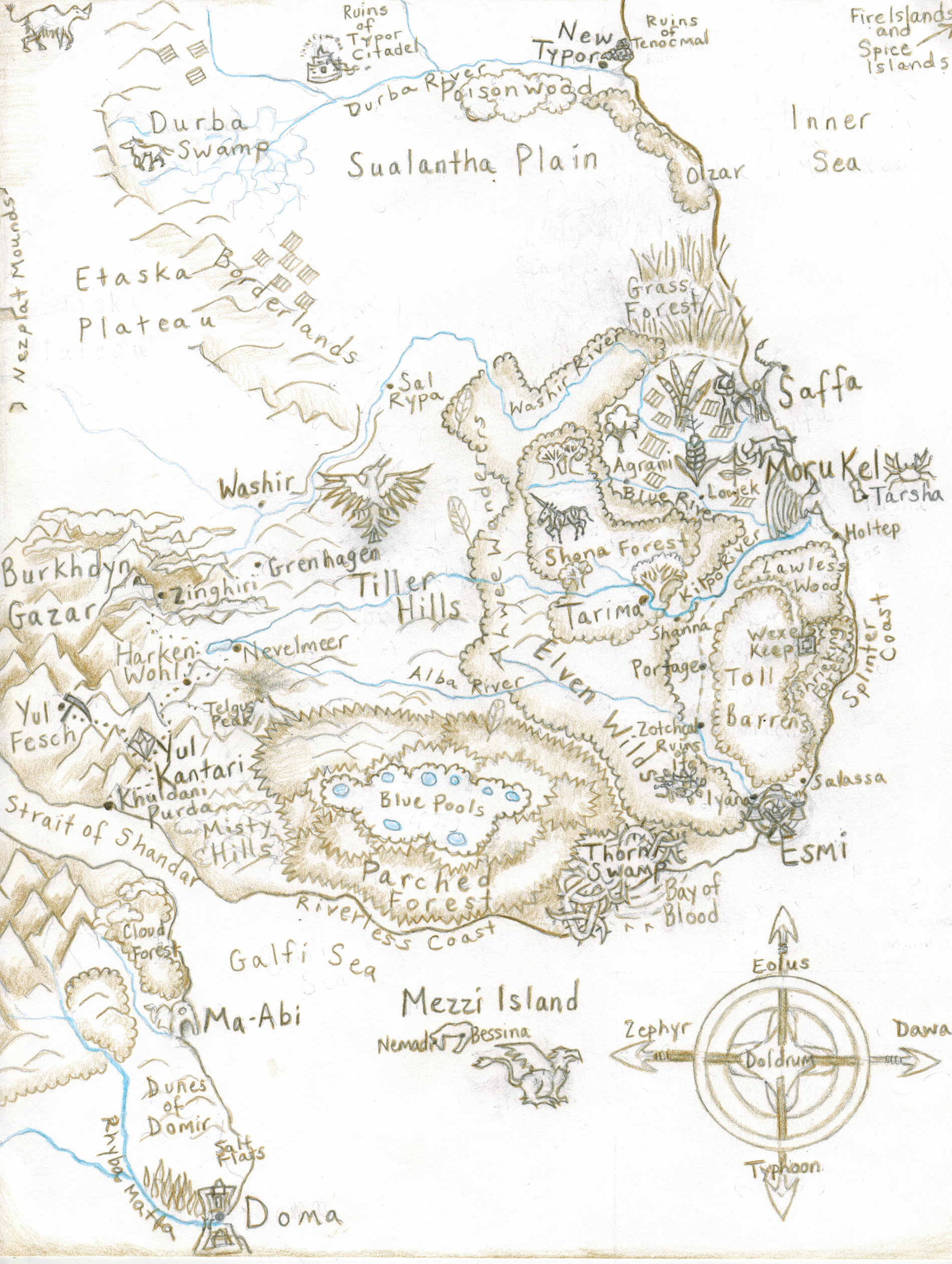History of the Continent
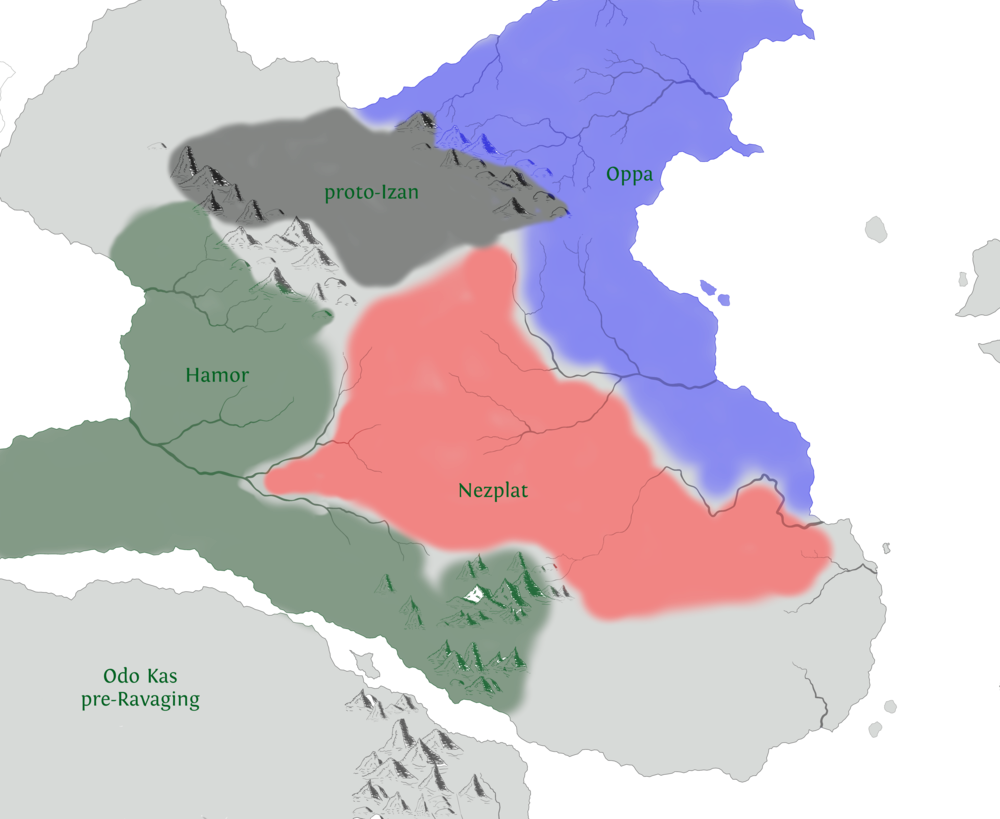
The time immediately after Dawa the Beyond brought forth the earth is shrouded in mystery. We know that there was the Awakening of the sentient species, and legends tell of a time of peace and tranquility following the Awakening. A few stories and songs tell of heartbreak, harvest, and heroes in ancient times. But little survived the Ravages of the Profane, when demons sprang forth, over ten centuries ago, plunging the realms of the sentient into a struggle for existence with the spawn of Tophet.
We know that, before the Ravages, two human groups occupied much of Odo Kas. One group, the Nezplat, lived mainly in the central plateaus, from Washir northward. They were nomadic hunters who built burial mounds in the great plains. No one knows why the demons left these structures untouched.
The other group, the Hamor, also left ancient structures, cairns on the southwest coast of Odo Kas. The Hamor spread from the Burkhdyn Gazar to Akkur Monz. They also lived in the eastern foothills of the Akkur Mons and eventually spread northeast. We now know that the tribes that moved into the northern plateau were cut off from the rest by orcish hordes, becoming the Oppa. Both the Oppa and Mena have strikingly similar versions of ancient chants that tell of this division. While the Oppa are directly descended from the Hamor, the Mena are a blend of Hamor and Nezplat peoples, as well as orcs and dwarves, as is evident from their language and customs. They are the survivors of those who sheltered in the mountains over the long centuries that demons wrought havoc upon Aardia.
Not all people sought refuge in the high peaks. Nearly half of the Nezplat refused to leave the plains. Though most of these were slain by demons, a significant number somehow managed to survive on the open plains. How they withstood or evaded the demons for over three hundred years is as mysterious as how the Ravages of the Profane began or ended. But the Ravages did end, and the ragged remnants of the Nezplat survived to become the Gamaal. At first, like their Nezplat ancestors, they were nomadic tribes, loosely connected by shared culture.
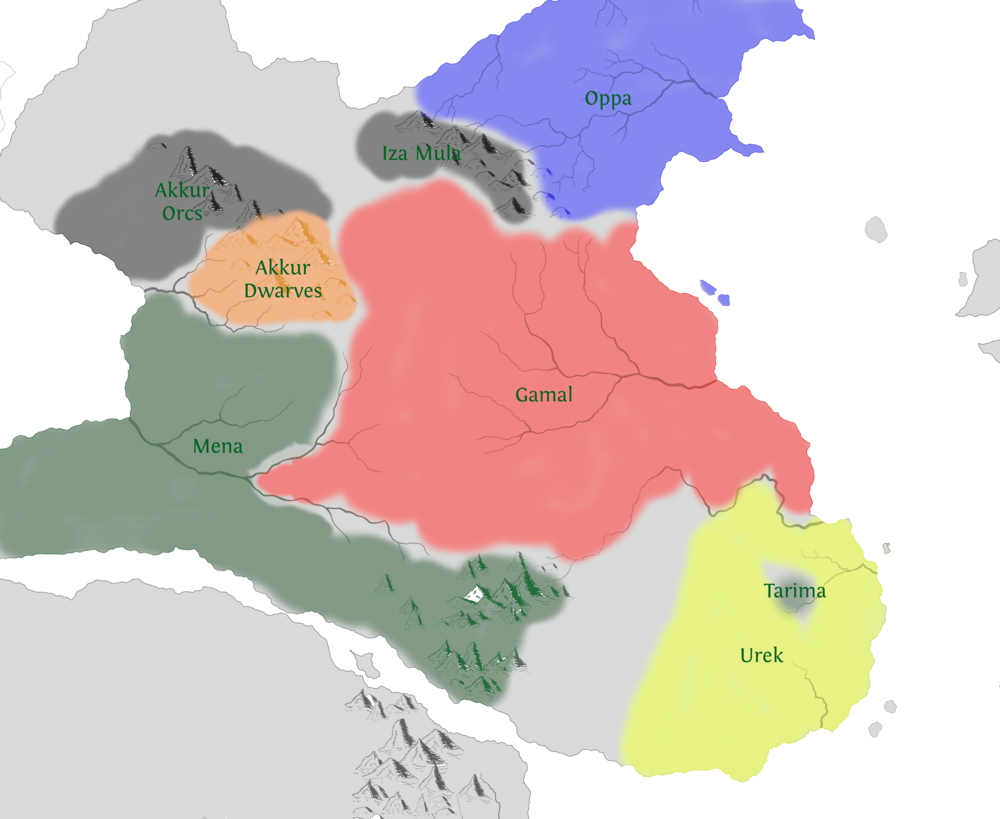
Following the Ravages, many Mena began to migrate back down to the lowlands, calling themselves the ‘urekal’, a word roughly translated as ‘returning ones’. Like the Gamaal, they were few in number and it took more than a century for their population to rebound. Unlike the Gamaal, they settled the land. Over time they began to build towns and then cities, with regions ruled by leaders called ‘chaxtas’. In 399 PS Chaxta Inwapel I founded the city of Skandara. Over the next century, a highly advanced civilization and culture developed in Skandara and Esmi, and ‘urekal’ became ‘Urek’. The southeast was officially united under Emperor Ocuil, in 284 PS, and the Urek Empire was born, with Skandara as its capitol.
The Urek Empire continued to grow, reaching its peak around 220 PS, under Emperor Tochac. During his reign the Urek lands stretched as far north as the Chawka River, where the Oppa lands began. All of the southeast was Urek, including the lost city of Axanga. The empire reached as far west as the Burkhdyn Gazar and the Gamaal territory of the Etaska Plateau. And the Gamaal began to take notice and to learn from the Urek.
As the Urek Empire passed its peak and suffered through two weak emperors, Khaivor Tarkhai unified the Gamaal into a terrifying force that swept through the plains and pushed east into the flatlands, burning the coastal Oppa city of Kiragal, including its docks and ships. The Gamaal were never a seafaring people and made their cities inland along the rivers, thus the attack on Kiragal took the Oppa by surprise.
Empress Neewah became the last leader of the Urek Empire in 165 PS. Just one year later, the Gamaal conquered the northernmost Urek city, Tenocmal, razing its famous blue towers. They built their own fortress, Typor Citadel, inland in the wretched swamps, and allowed the ruins of Tenocmal to be swallowed by the forest. The Gamaal pushed south, annexing Urek towns and cities, including Saffa, getting closer to Skandara. In 151 PS, they attacked the Urek capitol but were defeated by Whiro and his army, who flanked the Gamaal and decimated their forces. Whiro himself struck down the Gamaal leader, Tarkhai, ushering in a second Golden Age of Skandara. After Empress Neewah’s death, the empire resumed its decline, fragmenting into city states. When the Maelstrom opened, the ocean swallowed the temples of Skandara, hastening its collapse into obscurity.
The city of Tarima, once surrounded by the Urek Empire, now found itself an independent city-state on the edges of the much-reduced Urek culture.
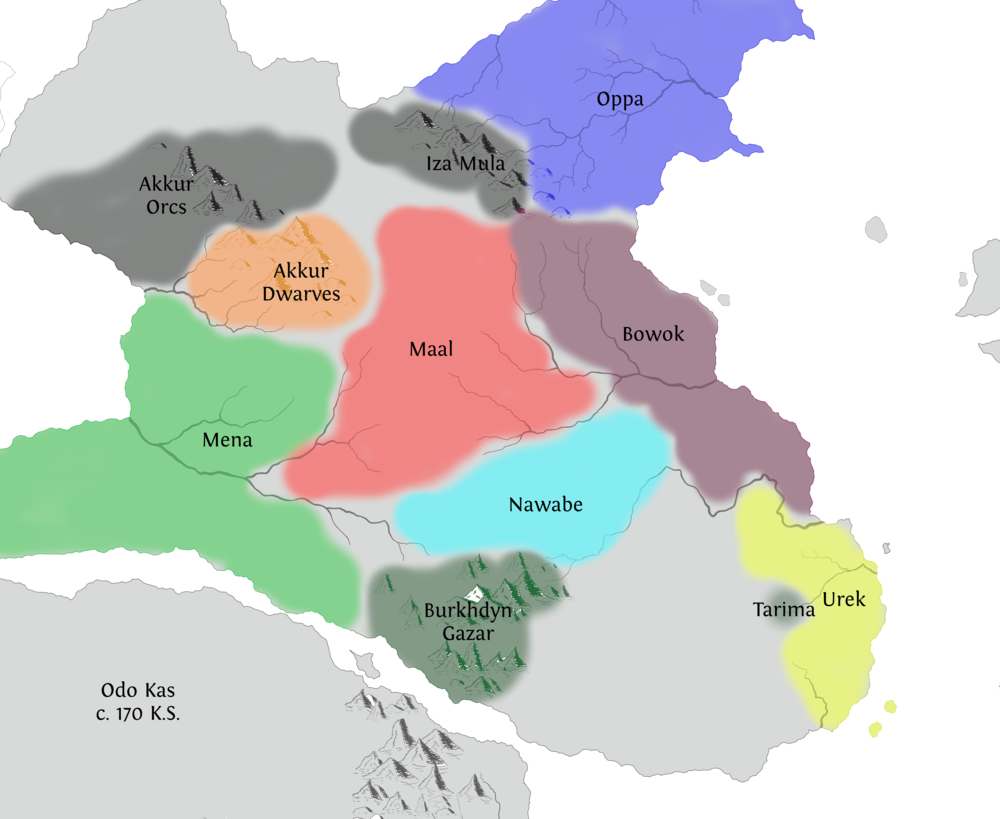
The Gamaal never recovered from their defeat in Skandara, or the loss of Tarkhai, and fractured into three groups: the Maal, the Nawabe, and the Bowok. These proved as terrifying as the Gamaal had been. The Maal occupied more northerly sections of the highlands and fought the orcs in the foothills of the Akkur Mons and Iza Mula mountains. This distracted the formidable Iza Mula orcs from battling the Oppa, giving the northern folk a much needed time of peace. The Maal and Nawabe fought over the central plateau, as the Nawabe controlled the southern Washir Plateau. The Maal eventually split into the Maal and Dalgar.
The Bowok controlled much of the coastal territory conquered by the Gamaal, and the Bowok slaughter of Saffan warriors, the Sorrow of Saffa, was the impetus for the creation of Saffa’s paired fighting style. The Saffans got their revenge, pushing the Bowok back and destroying Typor Citadel. The remnants of the Bowok only reclaimed and rebuilt it within the last century. The major Bowok city today is Wurdonne, populated by civilized and refined folk who appear to share few traits with their vicious ancestors.
In 376 KS, Jaleb Lango recolonized the ruins of Skandara, and over the next two generations its incredible sewer and water systems, stairwells, and tiered housing were painstakingly restored. When the Maelstrom was closed in 499 KS, by the Seven Heroes from the east, Tarsha emerged from the sea and was settled by islanders from the northwest.
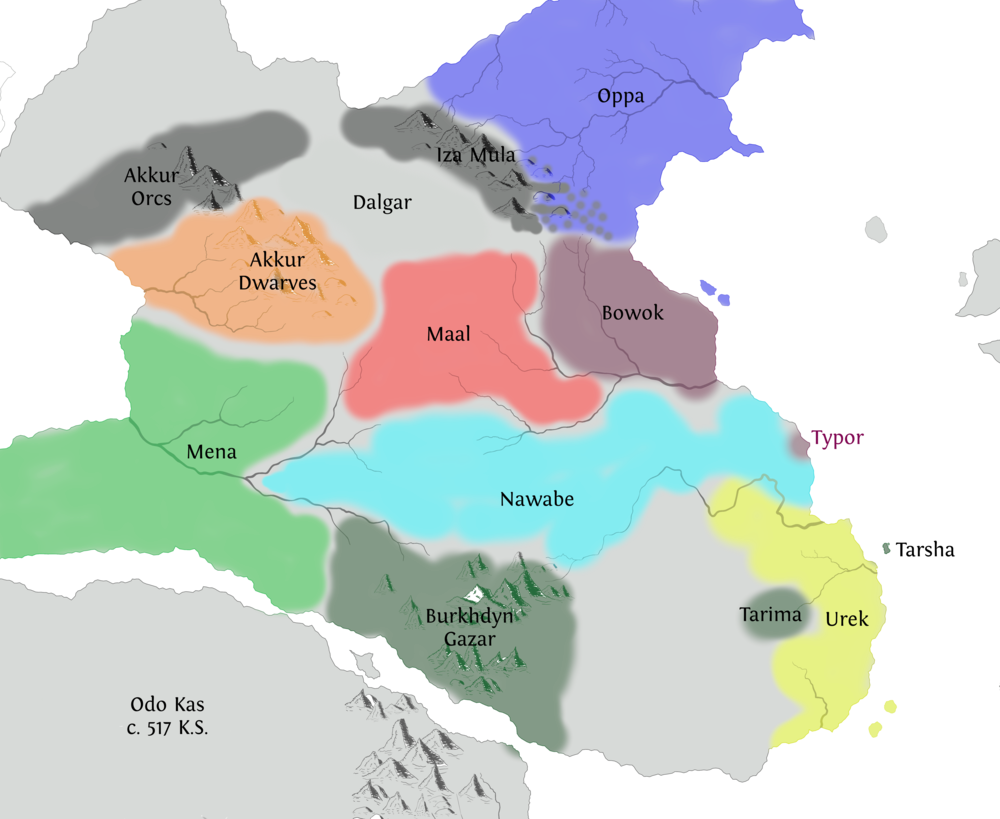
Timeline of Recent Events
- 151 PS
- Whiro’s Stand: Whiro defeats the Gamaal at the gates of old Skandara
- 1 KS
- Maelstrom created; Mezzi Island colonized by 4 Eastern ships. Skandara abandoned.
- 289 KS
- The Sorrow of Saffa; Saffa is sacked by the Bowok.
- 308 KS
- Citadel of Typor Destroyed, end of the Bowok as an Empire. The following year, a remnant of the Bowok heads north to found Wurdonne.
- 376 KS
- Moru Kel founded by Jaleb Lango
- 488–495 KS
- Rose Stone Craze
- 499 KS
- Maelstrom shut off
- 504–505 KS
- Epidemic kills many; Marghoz Amadi Lango accedes to the throne
